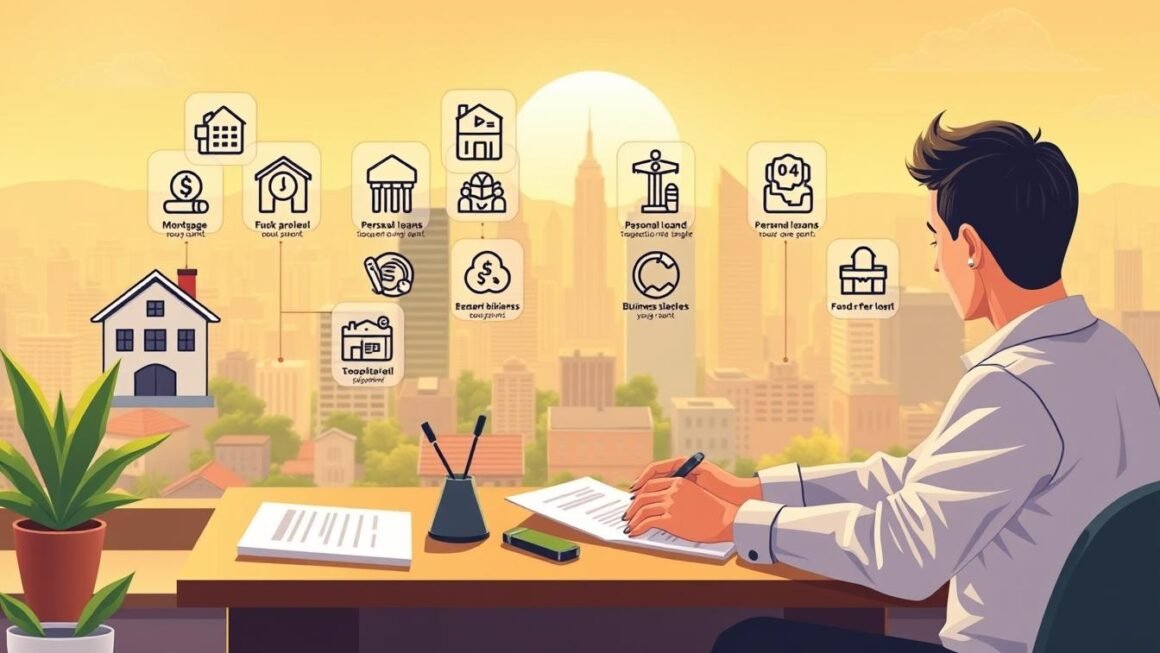Discover home loan secrets for 2025, including mortgage options, rate predictions, and application tips. Getting a home loan can feel overwhelming, especially with all the changes happening in 2025. As you prepare to buy a home, it’s important to understand your options and what to expect in the market. This guide will break down everything you need to know about securing a home loan this year, from different mortgage types to tips for improving your chances of approval. Let’s make this process a bit easier for you.
Key Takeaways
- Know the difference between conventional and government-backed loans to find what suits you best.
- Consider both fixed-rate and adjustable-rate mortgages for the best fit for your budget.
- Stay informed about economic trends that could affect mortgage rates and your buying power.
- Gather all necessary documents early to streamline your loan application process.
- Don’t forget to explore first-time homebuyer programs and down payment assistance options.
Exploring Mortgage Options for 2025
It can feel like there are a million different kinds of mortgages out there. Figuring out which one is right for you in 2025 is a big deal. Understanding the differences can save you money and stress.
Conventional vs. Government-Backed Loans
Conventional loans are the usual kind. For 2025, you’re probably looking at needing a credit score above 620, and the loan limits are going up a bit. The baseline limit for conventional loans will reach $806,500 for single-unit properties in 2025. If you’re in a pricier area, that limit could be as high as $1,209,750.
Government-backed loans have their own advantages:
- FHA loans are cool with lower credit scores and you only need to put 3.5% down.
- VA loans let eligible veterans buy a house without a down payment.
- USDA loans help people in rural areas buy homes without needing a down payment.
Adjustable vs. Fixed-Rate Mortgages
Fixed-rate mortgages are still super popular because they’re predictable. Rates should stay around 6% in 2025. Adjustable-rate mortgages (ARMs) are getting more attention because they start with lower rates. The catch? Those rates can change after a while. It’s a gamble, but it could pay off.
Digital Mortgage Innovations
The mortgage world is getting all tech-y in 2025. Automated systems are speeding up loan approvals and making fewer mistakes. Digital verification tools are also making the whole process faster. It’s all about making things easier for everyone.
The rise of digital mortgage platforms is changing the game. These platforms offer streamlined applications, faster approvals, and increased transparency. This means less paperwork and more control over your home-buying journey.
Understanding Mortgage Rate Predictions
It’s natural to feel a little uneasy thinking about getting a mortgage. The market is always changing, and interest rates can be unpredictable. Let’s look at what the experts are saying about rate predictions for 2025 to help you feel more confident.
Expert Forecasts and Market Indicators
Major research groups are suggesting that the average rate for a 30-year fixed mortgage will be around 6.34% by the end of 2025. Fannie Mae predicts rates will end up around 6.3%. The Mortgage Bankers Association is even more optimistic, suggesting rates could gradually decrease from 6.6% at the start of 2025.
Impact of Economic Trends
Economic policies really shape the mortgage landscape. Fiscal changes, like tax policies and government spending, can impact inflation and interest rates. Most experts think rates will stay above 6% for the year, but there could be some ups and downs. Timing your mortgage decisions could be key, as temporary rate drops might be good opportunities.
Strategies for Locking in Rates
Getting a good mortgage in 2025 starts with being prepared. A detailed budget helps you find ways to save money. Setting up automatic transfers to your savings account is a smart move. This helps build a solid financial base, making you a more attractive candidate for lenders.
Here are some things to keep in mind:
- Keep an eye on economic indicators.
- Consider a rate lock when you find a rate you’re comfortable with.
- Talk to multiple lenders to compare mortgage options.
Navigating the Housing Market Landscape
Current Market Trends
The housing market in early 2025 is a mixed bag. While some predict a slight cooling, others anticipate continued competition, especially in desirable areas. Inventory is still a key factor. We’re seeing a slow increase in available homes, but it’s not enough to satisfy demand in many cities. This means prices are staying relatively high, but the crazy bidding wars of the past few years are becoming less common. Keep an eye on local trends, as real estate is hyper-local. The housing market crash is not expected, but growth will be slow.
Buyer Opportunities in 2025
Despite the challenges, there are definitely opportunities for buyers in 2025.
- Slightly lower mortgage rates compared to the peak of 2024 are helping with affordability.
- More homes on the market mean buyers have more choices and slightly more negotiating power.
- New construction is picking up in some areas, offering fresh options.
It’s a good time to get pre-approved and start seriously looking, but don’t rush into anything. Take your time, do your research, and be prepared to walk away if the deal isn’t right.
Inventory and Pricing Insights
Inventory levels are slowly improving, but they’re still below historical averages. Pricing is a complex issue. Nationally, prices are expected to rise modestly, but some markets may see declines. Here’s a quick look at what experts are predicting:
| Region | Price Change (YoY) | Inventory Outlook | Notes |
|---|---|---|---|
| Northeast | +1% | Slightly Up | Stable market, limited new construction |
| Midwest | +2% | Flat | Affordable, but limited options |
| South | +3% | Up | Strong growth, new construction boom |
| West | 0% | Slightly Up | High prices, slowing demand |
Remember, these are just predictions. The best way to understand your local market is to work with a knowledgeable real estate agent. They can provide insights into mortgage for 2025 and help you find the right home at the right price.
Preparing for Your Home Loan Application
Getting ready to apply for a home loan can feel like a big deal, but breaking it down into steps makes it way more manageable. It’s all about getting your ducks in a row so lenders see you as a solid bet. Let’s walk through what you need to do.
Essential Documentation Needed
Okay, so first things first: paperwork. You’re going to need a bunch of documents to show the lender you’re good for the money. Think of it like proving you are who you say you are, and that you make the money you claim. Here’s a quick rundown:
- Proof of Income: This means pay stubs from the last couple of months, W-2s for the past two years, and if you’re self-employed, tax returns. Lenders want to see a steady income stream.
- Bank Statements: They’ll want to see statements from your checking and savings accounts. This helps them understand your spending habits and how much you have saved up. They’re looking for any red flags, like lots of overdrafts.
- Asset Verification: Got stocks, bonds, or other investments? You’ll need to provide statements for those too. This shows you have assets that can back up the loan.
- Identification: A driver’s license or other government-issued ID is a must. They need to verify your identity, of course.
- Credit History: While they’ll pull your credit report, it’s good to have your own copy handy. This way, you can spot any errors and address them before applying. You can get a free copy from Annual Credit Report.
Improving Your Credit Score
Your credit score is a big deal when it comes to getting a home loan. It’s like your financial report card, and lenders use it to decide if you’re a good risk. A higher score usually means better interest rates and loan terms. Here are some things you can do to boost your score:
- Pay Bills on Time: This is the biggest factor. Late payments can really hurt your score.
- Keep Credit Card Balances Low: Try to keep your balances below 30% of your credit limit. Maxing out your cards can lower your score.
- Don’t Open Too Many New Accounts: Opening a bunch of new credit accounts at once can make you look risky.
- Check Your Credit Report for Errors: Make sure everything on your report is accurate. If you find any mistakes, dispute them with the credit bureau.
Improving your credit score takes time, so start early. Even small changes can make a big difference in the long run.
Understanding Loan Estimates
Once you apply for a mortgage, the lender will give you a Loan Estimate. This document outlines the estimated costs of the loan, including the interest rate, monthly payment, and closing costs. It’s super important to understand this document so you know what you’re getting into. Here’s what to look for:
- Loan Terms: Check the loan amount, interest rate, and loan term (e.g., 30 years). Make sure these match what you discussed with the lender.
- Estimated Monthly Payment: This includes principal, interest, property taxes, and homeowner’s insurance. Make sure you can comfortably afford this payment.
- Closing Costs: These are the fees you’ll need to pay at closing, such as appraisal fees, title insurance, and lender fees. These can add up quickly, so it’s good to know what to expect. You can shop for a mortgage to compare loan estimates from different lenders.
- Compare Offers: Don’t just accept the first Loan Estimate you get. Shop around with multiple lenders to see who offers the best terms. A lower interest rate can save you thousands of dollars over the life of the loan.
Getting your paperwork in order, boosting your credit score, and understanding loan estimates are key steps to prepare for a mortgage. Take your time, do your research, and don’t be afraid to ask questions. You’ll be well on your way to securing a home loan in 2025.
Maximizing Your Home Loan Benefits

Utilizing First-Time Homebuyer Programs
Okay, so you’re a first-time homebuyer? Awesome! There are tons of programs out there designed to help you out. These aren’t just feel-good initiatives; they can seriously lower your costs. Look into programs offered by your state or even local municipalities. They often have grants or low-interest loans specifically for first-timers.
- Grants that don’t need to be repaid.
- Tax credits that reduce your tax burden.
- Educational resources to guide you through the process.
Exploring Down Payment Assistance
Down payments can be a huge hurdle. Down payment assistance programs (DPA) are designed to ease that burden. These programs come in different forms, like grants, second mortgages with deferred or forgiven payments, or even zero-interest loans. The eligibility requirements vary, so do your homework.
DPA programs can be a game-changer, but always read the fine print. Understand the terms, repayment schedules, and any potential strings attached. Some programs might have restrictions on selling the home within a certain period.
Understanding Closing Costs
Closing costs are all those extra fees that pop up when you’re finalizing your mortgage. They can include things like appraisal fees, title insurance, taxes, and lender fees. It’s important to understand what these costs are and how they impact your overall loan.
Here’s a quick breakdown of typical closing costs:
| Cost Type | Description
The Role of Technology in Home Loans
Technology is changing how we get mortgages. It’s making the process faster and, in some ways, easier to understand. Let’s look at some key areas where tech is making a difference.
Automated Loan Processing
Remember the days of endless paperwork? Well, automated loan processing is helping to reduce that. AI and machine learning are being used to speed up the approval process. AI technology can analyze data faster than humans, which means quicker decisions on your loan application.
This doesn’t mean humans are out of the picture. Instead, technology handles the repetitive tasks, freeing up loan officers to focus on more complex situations and provide better customer service.
Digital Verification Tools
Verifying your income and assets used to be a hassle. Now, digital verification tools are streamlining this process. These tools can securely access your bank statements and employment information, reducing the need for you to manually provide documents. This not only saves time but also reduces the risk of fraud. Here are some benefits:
- Faster verification times
- Reduced paperwork
- Increased security
Online Mortgage Applications
Applying for a mortgage online is becoming the norm. Many lenders now offer online applications that you can complete from the comfort of your home. This means no more trips to the bank or waiting in long lines. You can upload documents, track your application status, and communicate with your loan officer all through a secure online portal. It’s all about convenience and efficiency. Here’s what you can expect:
- Easy online application forms
- Secure document uploads
- Real-time application tracking
Common Mistakes to Avoid When Securing a Home Loan
Overlooking Pre-Approval
So, you’re thinking about buying a house, huh? Awesome! But before you start picturing yourself grilling in your new backyard, let’s talk about something super important: getting pre-approved. A lot of people skip this step, and honestly, it’s a huge mistake. Getting pre-approved gives you a realistic idea of how much you can actually borrow. It’s like knowing your budget before you hit the mall – prevents a lot of heartbreak later. Plus, sellers take you way more seriously when you’ve got that pre-approval letter in hand. It shows you’re not just window shopping.
Ignoring Loan Terms
Okay, so you got approved, congrats! Now comes the part where you actually read all that paperwork. I know, I know, it’s boring. But trust me, ignoring the loan terms is like driving a car without knowing the rules of the road. You might get somewhere, but you’re probably gonna crash. Pay close attention to the interest rate, of course, but also look at things like prepayment penalties, especially if you think you might want to pay off the loan early. And don’t be afraid to ask questions! If something doesn’t make sense, make the lender explain it. It’s their job.
Failing to Shop Around for Rates
Don’t just take the first offer you get! Shopping around for rates is like comparison shopping for anything else – you want to make sure you’re getting the best deal. Different lenders will offer different rates and terms, and even a small difference in interest can save you a ton of money over the life of the loan.
Here’s a quick checklist:
- Get quotes from at least three different lenders.
- Compare the APR (Annual Percentage Rate), not just the interest rate.
- Factor in any fees or points associated with the loan.
Remember, securing a home loan is a big deal. Take your time, do your research, and don’t be afraid to ask for help. It’s better to be a little bit annoying now than to regret your decision later.
Wrapping It Up: Your Path to Affordable Home Financing in 2025
So, there you have it. Getting a home loan in 2025 doesn’t have to be a headache. With the right info and a bit of planning, you can find a mortgage that fits your budget. Remember to check out different loan types, keep an eye on interest rates, and don’t forget about those extra costs like closing fees. It’s all about being prepared. Whether you’re a first-time buyer or looking to refinance, take your time to explore your options. The market is changing, and with the right approach, you can snag a great deal. Good luck out there!
Frequently Asked Questions
What credit score do I need to get a mortgage?
Most lenders want a credit score of at least 620, but if your score is higher, you might get better rates.
How much should I save for a down payment?
For conventional loans, you usually need to put down 3% to 20%, while FHA loans only require 3.5%.
What affects my chances of getting approved for a mortgage?
Your credit score, income, debt, and employment history all play a big role in getting approved.
What are closing costs, and how much should I expect?
Closing costs are fees you pay when finalizing your mortgage, usually between 2% to 6% of the loan amount.
Can I get a mortgage with a low credit score?
Yes, some loans, like FHA loans, allow lower credit scores, but you may pay higher interest.
What is the difference between fixed and adjustable-rate mortgages?
A fixed-rate mortgage has a constant interest rate, while an adjustable-rate mortgage can change after a set period.
VOCÊ ENCONTRARÁ O DOWNLOAD LOGO ABAIXO




